Madagascar trees Baobab
Madagascar trees Baobab.
Madagascar trees Baobab.
Madagascar trees Baobab.
Of the Diana and Mahajanga real estate agencies.
The most remarkable of the plant species of Madagascar is the Baobab tree. The very famous alley of the baobab trees of Morondava is the inevitable showcase.
The most remarkable of the plant species of the Big island is the Baobab tree or “Reniala” which literally means “mother of the forest” in Malagasy. On the eight species of Baobab tree of planet, six are present only in the Big island, which is the only country in the world to conceal forests of baobab trees. The baobab trees are ancient trees.
It presents a solid appearance, dominating and very original with a polished trunk and the branches, looking like roots, give the impression that the tree is upside down. The curiosity of these trees lies in the bulge of its branches and its trunk. This one is presented under various colors; it can be grayish, reddish,…
The trunk of the baobab trees measures, for certain species, up to 9 m diameter and 30 m of circumference. It constitutes an important water reserve which allows the tree to support the severe climatic conditions. This swollen trunk filled with water even was worth it the name “of bottle tree ”.
The baobab trees alley.
The sheets of baobab tree are very particular. They appear only for a very short length of time of the year because the baobab trees get rid of their sheet during the dry season in order to limit the water loss. The flowers of this tree are astonishing and are presented in form of several stamens with very varied colors, which go from white to yellow via the red. Flowering varies from one species to another.
To have the big brown fruits (40 cm length and 15 cm in diameter), which can contain tens of a thousand of seeds, the pollination of the baobab tree is generally ensured by bats, butterflies,… which all are nectarivores.
The ideal place to admire the baobab trees and to take pictures memories is in Morondava: the alley of the baobab trees. We can also see somewhere else as in Majunga, in Tuléar.
Another characteristic species of Madagascar is Ravinala, the tree of traveler or ravenala. This species, currently widespread in many countries, comes from the big island where it displays beautiful and in its full splendor. Currently, the tree of traveler takes over from secondary or primary forest sadly destroyed by fires or of land clearing. It deploys its sheets spread out at the end of the stems and confers on the hills and mountains deprived of forest covers a very attractive aspect. Its sheets sticking harmoniously around its large stem offer the shape of giant fan. The base of these sheets is a genuine very limpid water tank which can be of a great help when the sources are lacking. It is because of the existence of this accumulation of water in its petiole that this tree was named “tree of the traveler”.
Because of its quality which has equal only its natural beauty, the tree of traveller offers to the Malagasy gardens or parks a decorative appearance very appraisal which makes the target of a thousand of teleobjectives come from the four corners of the world.
Apart from the tree of traveler, more than 120 palm trees of various forms, from the simplest to the most unusual, remain in the Malagasy forests. A majority of these palm trees do not exist nowhere elsewhere than in Madagascar. Among the species of existing palm tree in the big island, we note Dypsis acuminum, Dypsis baronii, Dypsis occidentalis, Dypsis onilahensis, Dypsis lokohoensis, Dypsis perrieri, Dypsis decaryi, Chrysolidocarpus lutescens, Marojejya insignis, Dypsis bonsai and Dypsis pumila,…
The species are distributed on all the Malagasy territory, but some of them are endemic only in quite distinct areas. The Malagasy palm trees, especially those endemic regional, are represented and saved in the protected areas.
The Dypsis decaryi species, also called triangle palm tree or trihedral palm tree is very singular. The palms of this species are drawn up on three axes opposed to give an equilateral triangle. This form is visible as of the very beginning of the growth of the plant. This palm tree presents rather long and fine pennate sheets with leaflets harmoniously distributed on a petiole. The list of the endemic plants which make the charm and the originality of Madagascar is interminable and not finished, we still discover some regularly.
Thus, we also note a singular plant called Katrafay. This one is a plant of a very average size (12 to 15m). It spreads especially in the thorny forests of the southern part of the island and in the dry forests of the Malagasy west. It belongs to the family of Ptaeroxylaceas. The greyish and rough peel of katrafay is finely through grooves and cracks. This plant has a very singular flavour and it is especially famous for its therapeutic virtue. It is traditionally used to cure much disease or to alleviate the pains, especially in rural environment. It is also considered that Katrafay is simulative and aphrodisiac.
Madagascar also presents numerous species of purple woods belonging to the Papilionaceous family and Dalbergia, Pterocarpus kinds. These species currently are the subject strict regulation in their safeguarding because they rarefy. These plants which produce wood of quality for the cabinet work or joinery have a very slow growth. Consequently, their regeneration can take several years following a land clearing. At the present time, they are increasingly rare in the free forests but they still remain very visible in the parks of Madagascar.
Madagascar trees Baobab. Real Estate Madagascar. Madagascar trees Baobab. Real Estate Madagascar.




